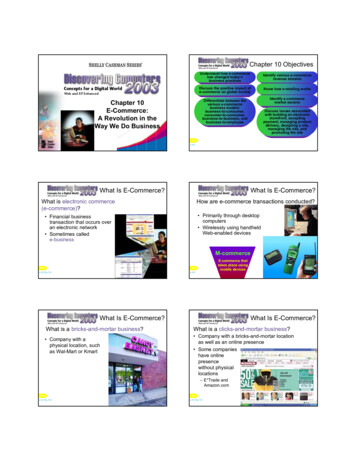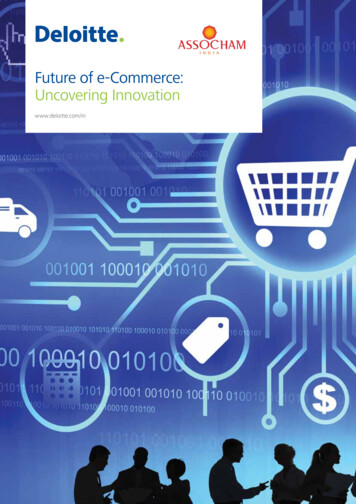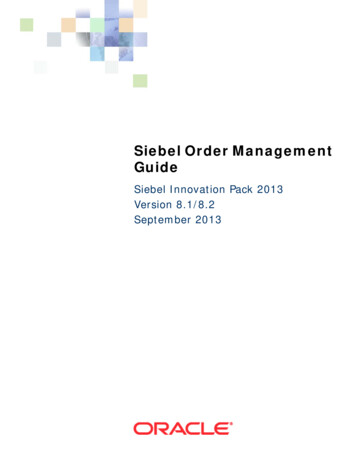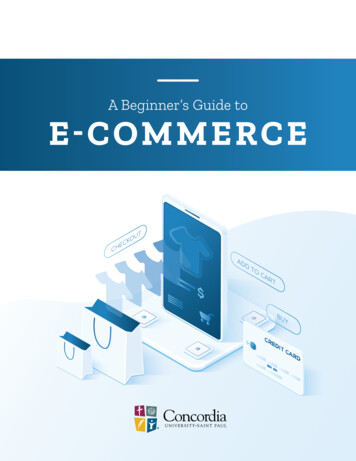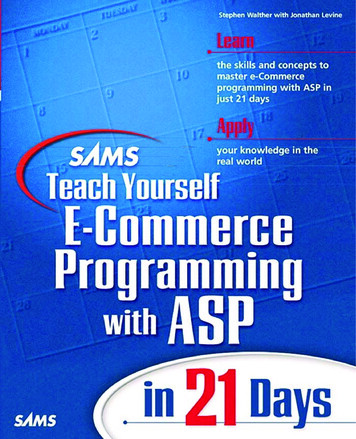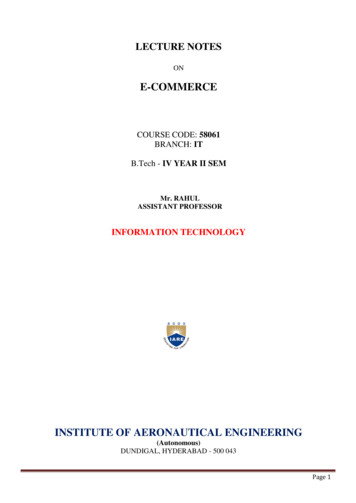
Transcription
MODULE 1: Understanding e-commerce. The role of e-commerce inchanging youth entrepreneurship as a careerE-entrepreneurSTRATEGIC PARTNERSHIP IN THE FIELD OF YOUTHProject ID: 2019‐2‐DK01‐KA205‐060317This project has been funded with support from theEuropean Commission. This publication reflects theviews only of the authors, and the Commission cannotbe held responsible for any use which may be made ofthe information contained therein.
CONTENTS:Introduction . 2I. The basics of e-commerce. . . .3The history of e-commerce . 3Types of e-commerce business models . . .5Impact of e-commerce . . . . . .8II. E-commerce and young entrepreneurs . 9Advantages of e-commerce. 10Disadvantages of e-commerce . . .13Must-have business skills for e-commerce young entrepreneurs . 15Conclusion . 201
INTRODUCTIONThe surge in internet usage has completely transformed the world of marketing, the waybusiness is conducted and has opened up great doors for young entrepreneurs toleverage their businesses using e-commerce solutions. Today no business can ignore thehuge virtual market that exist on the internet. E-commerce was inevitable becausephysical markets have literally been replaced with the virtual ones. E-commerce hasmade it possible for sellers to reach out to planet wide markets and consumers, thuschanging the way business is conducted. E-commerce brings its own unique advantagesand contribution to the businesses.Now more than ever, in this surreal experience of self-isolation across the globe causedby the ongoing Covid-19 pandemic, people are spending considerably more time onlineand e-commerce is on the rise. Quarantine has changed lives for all of us and somepeople are trying digital e-commerce services for the first time. As people are beingasked to practice social distancing, they are spending more time indoors and on theirmobile devices for shopping for goods and all essential items.In the first module of our e-learning courses, we will introduce youth workers, educatorsand young entrepreneurs to the basics of e-commerce, its features, impacts on societyand business. Moreover, we will see the advantages and disadvantages of e-commercefor young entrepreneurs and how e-commerce is changing youth entrepreneurship as acareer.2
I.The basics of e-commerceBy definition, e-commerce or electronic commerce, is the activity electronically buyingor selling of products on online services or over the Internet. Electronic commerce drawson technologies such as mobile commerce, electronic funds transfer, supply chainmanagement, Internet marketing, online transaction processing, electronic datainterchange (EDI), inventory management systems, and automated data collectionsystems. E-commerce is in turn driven by the technological advances of thesemiconductor industry, and is the largest sector of the electronics industry1.Let’s see the evolution of e-commerce.a. The history of e-commerceThe e-commerce was initially introduced about 40 years ago in its earliest form. In 1979,the English inventor Michael Aldrich introduced electronic shopping, which operated byconnecting a modified TV to a transaction-processing computer via telephone line. Thismade it possible for closed information systems to be opened and shared by outsideparties for secure data transmission – and the technology became the foundation uponwhich modern e-commerce was built. The system was marketed beginning in 1980 andoffered mainly business-to-business systems that were sold in the UK, Ireland, andSpain2.The world’s first e-commerce company was Boston Computer Exchange launched in1982. Its primary function was to serve as an online market for people interested inselling their used computers. Ten years later was launched one of the first onlinemarketplace for books, Book Stacks Unlimited. Originally the company used the dial-upbulletin board format, but in 1994 the site switched to the internet and operated fromthe Books.com domain. 1995 saw the launch of Amazon, introduced primarily as an ecommerce platform for books and that same year, Pierre Omidyar cehttps://www.bigcommerce.com/blog/ecommerce/#43
AuctionWeb, which would later become what we know today as eBay. Since then, bothhave become massive e-commerce selling platforms that enable consumers to sellonline to audiences around the globe.In 1998, PayPal hit the internet as a payment system for e-commerce. It merged withElon Musk’s online banking in 2000 to become the megastar site it is today. In 1999 waslaunched the online market place Alibaba that now is the world's largest retailer and ecommerce company. Alibaba.com was expected to improve the domestic e-commercemarket and perfect an e-commerce platform for Chinese enterprises, especially smalland medium-sized enterprises, to help export Chinese products to the global market aswell as address World Trade Organization challenges3.In 2000, Google introduces Google AdWords as a way for e-commerce businesses toadvertise to people using the Google search tool. With the help of short text ad copyand display URLs, online retailers began using the tool in a pay-per-click (PPC) context.Later in 2005, Amazon initiated Amazon Prime as a way for customers to get free twoday shipping for a flat annual fee. The membership also came to include other perks likediscounted one-day shipping and later access to streaming services like Amazon Videoand members-only events like “Prime Day.” Nowadays, free shipping and speed ofdelivery are the most common requests from online consumers. The same year was alsolaunched Etsy, a buyer and seller for small goods. This brought the makers communityonline –– expanding their reach to a 24/7 buying audience.BigCommerce launched its online platform in 2009. Along with Shopify (launched in2006) and Magento (2008), it leads the e-commerce market. In 2011, Google Wallet wasintroduced as a peer-to-peer payment service that enabled individuals to send andreceive money from a mobile device or desktop computer. By linking the digital walletto a debit card or bank account, users can pay for products or services via these devices.Today, Google Wallet has joined with Android Pay for what is now known as Google Pay.Also, in 2011, Facebook introduced advertising in the form of sponsored stories. Thisgave e-commerce sellers more opportunities to advertise their products to targeted3https://en.wikipedia.org/wiki/Alibaba Group4
audiences. The same year Stripe was also launched as a payment processing system fordevelopers.In 2014, Apple Pay rushed to the e-commerce scene and made payment of services moreconvenient through a mobile device. Buyers could attach their debit or credit cards totheir phone and order online. Jet.com was also founded in 2014 by entrepreneur MarcLore (who had sold his previous company, Diapers.com, to Amazon.com) along withMike Hanrahan and Nate Faust. The company competes with Costco and Sam’s Club,catering to folks looking for the lowest possible pricing for longer shipping times andbulk ordering.Instagram Shopping launched in 2017 first with e-commerce partner BigCommerce.Since then, the service has expanded to additional e-commerce platforms and allowsInstagram users to immediately click an item, and go to that product’s product page forpurchase.The e-commerce market has evolved from a simple counterpart of brick and mortarretail to a shopping ecosystem that involves multiple devices and store concepts. Now,when looking at the e-commerce landscape, we see a relatively mature market withestablished players and a clear set of rules, but this impression can be misleading,because the digital transformation is not over yet.b. Types of e-commerce business modelsBefore to start with their e-commerce business, youth need to familiarize themselveswith each type of business model. Generally, there are six main models of e-commercethat businesses can be categorized into: Business-to-Consumer (B2C), Business-toBusiness (B2B), Consumer-to-Consumer (C2C), Consumer-to-Business (C2B), Businessto-Administration (B2A) and Consumer-to-Administration (C2A).5
B2C e-commerce encompasses transactions made between a business and a consumer.This is one of the most widely used sales models in the e-commerce context andexamples of B2C are everywhere. In the product-based B2C model, businesses sellproducts to consumers through the use of online marketplaces and stores. There aretwo models: direct sellers, when consumers purchase goods directly from themanufacturers via their online retailers; and online intermediaries, the online ecommerce platforms such as Etsy, that help bring together the buyers and sellers. Theplatform themselves do not make the products or services listed on the site.A company with a service-based B2C model functions exactly as its namesake – it helpsprovide services to its consumers. A service-based B2C company earns revenue byproviding services instead of selling physical products. Netflix and Spotify are greatexamples of a “service-focussed” software-based B2C companies. Both help providevideo and music services to consumers via the use of the software.Unlike B2C, Business-to-Business e-commerce relates to sales made betweenbusinesses, such as a manufacturer and a wholesaler or retailer. This type of ecommerce is not consumer-facing and happens only between business entities. Mostoften, business-to-business sales focus on raw materials or products that arerepackaged or combined before being sold to customers.There are B2B companies in every industry, from manufacturing to retail. Whereverbusiness is done, you can be sure a host of B2B suppliers and advisory firms are active.Every B2C company requires certain products, services and professional counsel, soevery B2C company generates B2B activity. Examples of real-world B2B activity areplentiful and more visible than you might guess. For example, the cloud-baseddocument storage company Dropbox serves businesses as well as individuals. GeneralElectric makes plenty of consumer goods, but it also provides parts to other enterprises.Xerox is a household name but makes billions providing paper and print services 000-what-is-b2b.html6
Consumer-to-consumer (C2C) markets provide an innovative way to allow customers tointeract with each other. Traditional markets require business to customer relationships,in which a customer goes to the business in order to purchase a product or service. Incustomer to customer markets, the business facilitates an environment wherecustomers can sell goods or services to each other. Created by the rise of the ecommerce sector and growing consumer confidence in online business, these sites allowcustomers to trade, buy, and sell items in exchange for a small commission paid to thesite. Opening a C2C site takes careful planning.Consumer-to-Business (C2B) reverses the traditional e-commerce model and it is alesser-known form of e-commerce. C2B is similar to C2C in that an intermediary is oftenrequired. This online commerce business is when the consumer sells goods or servicesto businesses, and is roughly equivalent to a sole proprietorship serving a largerbusiness. An example of this would be a business model like iStockPhoto, in which stockphotos are available online for purchase directly from different photographers. Thebusiness then pays for the right to use the stock photo and the intermediary site hoststhe transaction, transferring the money and information online.Business-to-Administration (B2A) is when a business provides an online service for thegovernment, generally through a website. One way to understand B2A e-commerce isthrough taxes. Taxes, which go to the government, can be filed online through thirdparty businesses, such as TurboTax or H&R Block.Consumer-to-Administration (C2A) occurs when a consumer is providing something forthe government. A C2A transaction can be as simple as paying for parking tickets orordering a new government ID. However, to be considered a C2A e-commercetransaction, this must be done online. While C2A and B2A aren’t the most important ecommerce types today, both are an important part of the future of online transactions -business-models/7
c. Impact of e-commerceE-commerce has the potential to radically alter economic activities and the socialenvironment, affecting large sectors such as communication, finance and retail trade. Ecommerce transforms the marketplace and the way business is conducted. Traditionalintermediary functions are replaced, new products and markets are developed, new andfar closer relationships are created between business and consumers. Moreover, ecommerce has wider implications for economic growth employment and the nature offuture jobs.The advancement of technology has aided international business and the Internet isprofoundly affecting almost all businesses. The various uses of internet by businessentities include the ability to advertise, generate, or otherwise perform regular businessfunctions. One impact for e-commerce is to intensify competition and to producebenefits to consumers in lower prices and more choices. Moreover, e-commerce bringsconvenience for customers as they do not have to leave home and only need to browsewebsite online, especially for buying the products which are not sold in nearby shops. Itcould help customers buy wider range of products and save customers’ time.Consumers also gain power through online shopping. They are able to research productsand compare prices among retailers. Also, online shopping often provides salespromotion or discounts code, thus it is more price effective for customers. In addition,customers can also review and track the order history online. However, e-commercelacks human interaction for customers, especially who prefer face-to-face connection.Customers are also concerned with the security of online transactions and tend toremain loyal to well-known retailers.E-commerce is expected to directly and indirectly create as well destroy jobs. It will helpscreate new job opportunities due to information related services, entertainment,software app and digital products, but jobs will be lost when e-commerce substitutesfor the traditional way of doing business. The development of e-commerce will createjobs that require highly skilled workers to manage large amounts of information,customer demands, and production processes. In contrast, people with poor technicalskills cannot enjoy the wages welfare. On the other hand, because e-commerce requires8
sufficient stocks that could be delivered to customers in time, the warehouse becomesan important element. Warehouse needs more staff to manage, supervise and organize,thus the condition of warehouse environment will be concerned by employees.II.E-commerce and young entrepreneursThe role of entrepreneurship in job creation and unemployment reduction is wellestablished and play a vital role in creating self-employment for young people. Differentstudies have shown that entrepreneurship interventions can effectively boostemployment and earnings among young people benefiting both booming and slow jobgrowth economies through innovation and by stimulating competition.Now, with the rise of e-commerce and the rapid growth of online shopping, youngentrepreneurs have more opportunities for starting their business and expending theirboundaries by opening an online store. Moreover, running an e-commerce business ismore effective and productive, and there is less capital investment required comparedto owning a physical storefront. The only important is that young entrepreneurs have todeliver quality products or services to the consumers on time and promote theirbusiness in different ways.Like all businesses models, e-commerce has its advantages and disadvantages. Onceyoung entrepreneurs learn what are the pros and cons of this business model, they canmake better their strategic decisions.Let s start with the advantages of e-commerce!9
a. Advantages of e-commerce Overcome geographical limitationsE-commerce allows young entrepreneurs to reach customers all over the country andaround the world. If they have a physical store, they will be limited by the area that theyserve. With an e-commerce website, young entrepreneurs have the ability to discovernew markets and sell internationally, allowing them to see profit long before their localcompetitors. Moreover, customers can purchase not just anywhere but also anytime,especially now when more people are getting used to shopping on their mobile devices. No opening time restrictionsAnother important advantage of e-commerce is that online stores are always open forbusiness and there are no restrictions for the potential customers, as they can view thewebsite at any time of the day. Moreover, thanks to different sales initiatives such asspecial offers and online marketing, young entrepreneurs can attract more customerswho would prefer to order at night. For such a customer order, young entrepreneursdon’t need to have employees working night shift, neither security guard who has totake care of the shop. Eliminate travel time and costIt s again about time. With the online shop, young entrepreneurs can allow customers,with just a few mouse clicks to order from the store and avoid going to the physical storeand lose time as well as travel long distances. Moreover, once the e-commerce websitehas been initially set up, young entrepreneurs don’t need to invest too much time intorunning it. This is because the whole process for customers ordering and makingpayments will all be activated through the online system. This will give entrepreneursmore time to determine new products they want to sell, special offers they want tolaunch and to track how successful their sales are. They will also be able to determineany trends in terms of which products are selling most successfully.10
Lower costsWith the advance in e-commerce platform technologies, it has become very easy andaffordable to set up and maintain an e-commerce store with a low overhead. Merchantsno longer have to spend a large budget on TV ads or billboard, nor worry about theexpense for personnel and real estate. Especially for young entrepreneurs, e-commerceoffers a lower startup cost. They do not have to pay rent for their store location, neitherfor the store design, buying inventory, sales equipment, and much more 6.Moreover, physical retail stores are paying staff to work and run the store. In the caseof e-commerce business, depending on what type of e-commerce entrepreneurs have,they may only need to hire employees when their grow to certain level. But in the caseof online store, these employees can work remotely and also will be easier to find thestaff that is suitable for the type of the company. For the young entrepreneurs that arelooking to keep their costs low, e-commerce business is very attractive because of thisadvantage that its bringing to them. Another costs that young entrepreneurs can saveare electricity, heating costs, rent, etc. All this money that they could save, can be usedto develop their e-commerce website and product range further. Easy to showcase bestsellersAnother benefit of e-commerce business is that allow young entrepreneurs to easilydisplay their best-sellers products. Effectively promoting the right products categoriesand products on the site is crucial for the overall business success. Often, a website hastoo many products that a company offer, so it s more difficult for customers to gothrough all of them. Are you wondering why is good for young entrepreneurs topromote their best-sellers products? The answer is very easy. Because they are provenand if other customers have already bought them and are happy with their purchase,this means that entrepreneurs need to focused on promoting these products, so theycan gain more customers and business advantages-and-disadvantages11
Gain access to customer data easilyOne advantage of online selling is how easy it makes it to collect, measure, and act oncustomer data. If young entrepreneurs want to be focused on the customer experience,then they need to have the customer data. Most people feel uncomfortable giving awaytheir email addresses or telephone numbers to physical retailers, but with e-commerceentrepreneurs can easily gain access to data for analysis on their customers such asname, mailing address and phone number. That means that entrepreneurs have at leastthree different ways to communicate and build relationship with their customers. Thecollection of this type of data helps to create distinguished target markets and allowsfor improved customer communications, encouraging online commerce sites to focuson customers’ wants and needs. When entrepreneurs know what customers want,issues and problems can be resolved easier.However, young entrepreneurs have to keep in mind that if they customers are basedwithin Europe, they need to be careful with the GDPR regulations when contactcustomers. More about the GDPR regulations, you will learn in one of the followingmodules. Content marketing strategy and abundant informationThere are limitations to the amount of information that can be displayed in a physicalstore as well as is difficult to equip employees to respond to customers who requireinformation across product lines. With e-commerce, young entrepreneurs can providemore information about their services or products to their customers. Key productcontent includes detailed product descriptions, product comparisons, demo videos,reviews, etc. Moreover, e-commerce site can also provide information about thebusiness and how to use the products. Webpages and email marketing can be dedicatedto the brand’s story and how the products are made. Blog posts and videos can alsoprovide helpful content about the use of the products or services.Also with e-commerce, young entrepreneurs can grow organic traffic and sales with ecommerce blogging. From making videos to writing blog content, they will be able tooptimize their store to drive traffic and sales without having to spend more money.12
Little-to-no overhead cost for digital productsThanks to e-commerce, consumers can purchase music, videos, or booksinstantaneously. Stores can now sell unlimited copies of these digital items, withouthaving to worry about where they'll store the inventory.b. Disadvantages of e-commerceRunning an e-commerce business have its own challenges and disadvantages, so let ssee some of them. Customers can t try before they buySome consumers value the personal touch they get from visiting a physical store andinteracting with sales associates. Such personal touch is particularly important forbusinesses selling high-end products as customers not only want to buy the merchandisebut also have a great experience during the process. Moreover, no matter how good avideo is made, consumers still can't touch and feel a product. Not to mention, it's not aneasy feat to deliver a brand experience, which could often include the sense of touch,smell, taste, and sound, through the two-dimensionality of a screen. Credit card fraud and securityCredit card fraud is a real and growing problem for online businesses. It can lead tochargebacks that result in the loss of revenue, penalties, and bad reputation. Consumersrun the risk of identity fraud and similar hazards every time they enter their details intoa site. If the site doesn't convince shoppers that the check-out process is secure, theycould get scared out of buying. On the other hand, businesses run the risk of phishingattacks and other forms of cyberattacks. If young entrepreneurs open just one maliciouslink, it could compromise the website functionality, financial information—or worst ofall, the customers' information.13
Site crashE-commerce is fully dependent on internet connection. One of the worst e-commercedisadvantages is when no one can buy from the online store because of the site crashes.That s why is very important for young entrepreneurs to ensure that their website ishosted on the right platform, because even just a few minutes of downtime ortechnology hiccups can cause a substantial loss of revenue and customer dissatisfaction. Price and product comparisonConsumers can easily compare prices with a simple click, rather than crossing town tocheck another store. Many shoppers will search for the absolute lowest price, and if theentrepreneur can't offer it, he or she will probably lose the sale. Highly competitiveIn the era we live, the online storefront providers bring everyone the ability to set up ane-commerce store within minutes. The lowered barriers to entry might be a greatattraction to the aspiring e-commerce young entrepreneur, but for customers thereliability can be an issue 7 . They may restrict their online purchases to famous ecommerce websites. Moreover, the best niches are often the most competitive that’swhy people are drawn to them. The more competitive a niche is, the more expensiveads for that niche are.Anyway, young entrepreneurs can go after a different audience than their competitors.For example, if the customers are being targeted by competitors through Facebook ads,they might try ranking organically with SEO optimization. If the competitors are usingPinterest for their marketing strategy, young entrepreneurs might try with ages-of-e-commerce-114157114
c. Must-have business skills for e-commerce young entrepreneursTo be successful in the online environment, every young entrepreneur need to have ecommerce skills. Just like any other set of skills, fortunately also e-commerce skills canbe learned. However, all young entrepreneurs need to have some intangible skills suchas leadership or strategic planning, but now we will list mainly the must-have skillsneeded for growing successful e-commerce business. Understand web fundamentalsUnderstand web fundamentals doesn’t mean that young entrepreneurs have to be afirst-class programmer in order to build a successful online business, but they will needto learn some core web fundamentals to successfully run the business. Some key skillsto learn include hosting fundamentals such as domain registration, setting up nameservers, using File Transfer Protocol, deep linking, and URL redirection. Additionally,learning HTML & CSS will go a long way in helping entrepreneurs to make changes totheir e-commerce website, to add elements, and to find broken pieces of code.Moreover, choosing the right business model and platform is a vital aspect of startingan online business. To pick the right ones, young entrepreneurs need to know how theywork and what characteristics point to the best one for them. Furthermore, they needto know the actual, practical applications of their working parts. Without these ecommerce skills or without knowing the most suitable e-commerce business model ande-commerce platform and how to use them, their business could be doomed before iteven has a chance to launch.15
Understand the value of contentThe ability to create quality, value-added and search engine-optimized content is key torunning a successful online business in today’s online environment. Content drivestraffic, builds trust and attracts new leads and customers to every business.E-commerce young entrepreneurs need to have the ability to write and communicatetheir idea, so they can easily attract attention online, and bring people andproducts/services together. To convey an idea, they need to use proper sentenceformation, correct grammar as well as they also need to learn how to write long-formcontent for blog posts, press releases and to do proper email marketing. Contentcreation can also include videos, case studies, research papers, infographics, podcasts,webinars, and online courses. In addition, online presence is crucial for the e-commercebusiness and knowing how to use social media tools for brand building is must to have.More about marketing strategies and contents, you will learn in the last module of oure-learning courses. Have great project management skillsThere a lot of management skills that young entrepreneurs require to succeed inbusiness. To create a successful and sustainable e-commerce platform, projectmanagement is an utterly important and indispensable skill 8.For example, time management is the creation of tools and processes that allowindividuals and organizations to accomplish more in a set time period. While timemanagement is critical to success for all individuals, it is critically important to youngentrepreneurs. This is because they are typically faced with tons of challenges each dayand quickly compile massive “To Do” lists. For e-commerce, young entrepreneurs needto have time management skills to ensure that orders are processed the same day ce-entrepreneurs/16
customers order. They need to take care of multiple channels such as inventory,marketing, logistics, finance, and a part of the time, more requires proper projectmanagement skills. A very important set of e-commerce skills is knowing how to useonline tools to streamline operation
systems. E-commerce is in turn driven by the technological advances of the semiconductor industry, and is the largest sector of the electronics industry1. Let’s see the evolution of e-commerce. a. The history of e-commerce The e-commerce was initially int

